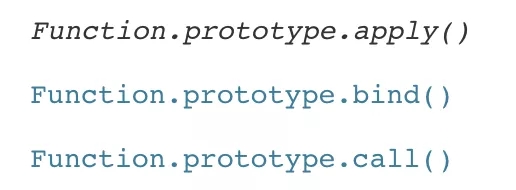在课程 连接你、我、他 —— this 中我们学习了 this,最后留了一个问题,如何修改 this 的指向,今天一起学习。
修改 this 的指向可通过 apply、call、bind 这三个函数中的任意一个实现。那这三个函数是谁的方法呢?
在 MDN 中我查到了:
这张图说明了这 3 个函数是 Function prototype 的方法,也就是说「每个函数都有着三个方法」。当定义一个函数,这个函数默认包含这三个方法。
我们感受一下 Vue.js 中关于 apply、call 和 bind 的使用:
apply 的应用:
- function once (fn) {
- var called = false;
- return function () {
- if (!called) {
- called = true;
- fn.apply(this, arguments);
- }
- }
- }
call 的应用:
- var hasOwnProperty = Object.prototype.hasOwnProperty;
- function hasOwn (obj, key) {
- return hasOwnProperty.call(obj, key)
- }
bind的应用:
- function polyfillBind (fn, ctx) {
- function boundFn (a) {
- var l = arguments.length;
- return l
- ? l > 1
- ? fn.apply(ctx, arguments)
- : fn.call(ctx, a)
- : fn.call(ctx)
- }
- boundFn._length = fn.length;
- return boundFn
- }
- function nativeBind (fn, ctx) {
- return fn.bind(ctx)
- }
- var bind = Function.prototype.bind
- ? nativeBind
- : polyfillBind;
你可能看不懂上面的用法,下面我们一一抛开谜底。
当一个新事物的出现,总是有目的的,那么 apply、call 和 bind 的出现是为了解决什么问题呢?它们为什么是函数的方法呢?为什么不是其它对象的方法。
通过 apply、call 可以自定义 this 调用某个函数,比如定义一个全局函数(严格模式):
- 'use strict';
- function gFun(name, age) {
- console.log(this);
- }
这个函数可以通过下面 5 种方式调用,也就是说通过 apply、call、bind 可以调用一个函数 F,其中「函数 F 执行上下文中的 this 可以在调用时指定」:
1.直接调用:
- gFun('suyan', 20); // this 为 undefined
2.通过 this 调用:
- this.gFun('suyan', 20); // this 为 window
3.通过 apply 调用,把所有的参数组合成一个数组作为 apply 的参数:
- gFun.apply(this, ['suyan', 20]); // this 为 window
4.通过 call 调用,参数通过逗号分割,这是与 apply 调用的区别:
- gFun.call(this, 'suyan', 20); // this 为 window
5.通过 bind 调用,会返回一个原函数的拷贝,并拥有指定的 this和参数:
- let bGFun = gFun.bind(this, 'suyan', 20);
- bGFun(); // this 为 window
我们一起看一些例子:
例1、setTimeOut 的使用:
- const time = {
- second: 1,
- afterOneSecond() {
- setTimeout(function () {
- this.second += 1;
- console.log(this.second);
- }, 1000);
- }
- };
- time.afterOneSecond();
上面这段代码执行后,第 6 行代码的打印结果是 NaN,在连接你、我、他 —— this 这节课程中我们有提到过 this 设计的一个弊端是不能继承。其实可以通过 bind 改造一下这个函数:
- const time = {
- second: 1,
- afterOneSecond() {
- setTimeout(this.timeInvoke.bind(this), 1000);
- },
- timeInvoke() {
- this.second += 1;
- console.log(this.second);
- }
- };
- time.afterOneSecond();
函数 timeInvoke 通过 bind 绑定 this,并返回一个新的函数,执行结果为 2。bind 好像具有「暂存」的功能,把当前的 this 暂存起来。
例 2、函数调用
- const person = {
- name: 'suyan',
- age: 20,
- showName(pre) {
- return pre + '-' + this.name;
- },
- update(name, age) {
- this.name = name;
- this.age = age;
- }
- };
- function generateName(fun) {
- let name = fun();
- console.log('showName = ', name);
- }
- generateName(person.showName);
执行上面代码会报错,因为 showName 中的 this 为 undefined:
可以通过 bind 「暂存 this」:
- const person = {
- name: 'suyan',
- age: 20,
- showName(pre) {
- return pre + '-' + this.name;
- },
- update(name, age) {
- this.name = name;
- this.age = age;
- }
- };
- function generateName(fun) {
- let name = fun();
- console.log('showName = ', name);
- }
- // 指定 this 为 person 对象
- let bindShowName = person.showName.bind(person, '前端小课');
- generateName(bindShowName);
例 3、构造函数,通过 call 来调用某个函数,替换 this。
- function Product(name, price) {
- this.name = name;
- this.price = price;
- }
- function Food(name, price) {
- // 调用 Product 函数
- Product.call(this, name, price);
- this.catagory = 'food';
- }
- let food = new Food('包子', 1);
- console.log(food.name); // 包子
例 4、调用匿名函数
- const animals = [
- {
- name: 'King'
- },
- {
- name: 'Fail'
- }
- ];
- for (let i = 0; i < animals.length; i++) {
- (function (i) {
- // 可以直接使用 this
- this.print = function () {
- console.log('#' + i + ' ' + this.name);
- };
- this.print();
- }).call(animals[i], i);
- }
结果为:
回头再看看课程开始之前 Vue 中关于 apply、call 和 bind 的应用,是不是能看懂了?































